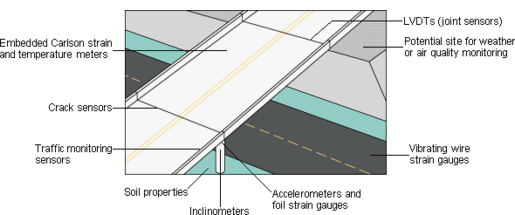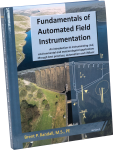What We Do
Campbell Scientific data-acquisition (DAQ) systems have versatile capabilities that make them ideal for structural health monitoring in a wide range of applications, including simple beam-fatigue, structural mechanics research, and continuous monitoring of large, complex structures. Each system can measure a variety of sensor types, including bonded foil strain gauges, accelerometers, displacement sensors (potentiometer-based, LVDT, and VW) tiltmeters, and temperature sensors.
Our VSPECT® technology provides the highest measurement precision of vibrating wire sensors available, sensor diagnostics to extend the useful life of the monitoring project, and noise immunity, which eliminates the need for post-processing of vibrating wire sensor data. Campbell Scientific’s family of data loggers and DAQ systems are currently being used for remote, unattended, and portable monitoring for highway overpasses, roads, buildings, retaining walls, bridges, and amusement park rides. Since 1974, Campbell Scientific has been known worldwide for rugged, accurate, and reliable measurement systems.
Watch the GRANITE™ Extreme Sensitivity video, the GRANITE™ Dynamic Range video, and the GRANITE™ Series Data Acquisition video.
Learn about our patented VSPECT spectral-analysis technology at our VSPECT Essentials web resource.
The dynamic vibrating wire measurement technique is protected under U.S. Patent No. 8,671,758, and the vibrating wire spectral-analysis technology (VSPECT) is protected under U.S. Patent No. 7,779,690.
Unlock the power of instrumentation and monitoring with our various geotechnical training options.
Learn moreCheck out some awesome examples of what our equipment can do in this area
Customise a System
In addition to our standard systems available, many of the systems we provide are customised. Tell us what you need, and we’ll help you configure a system that meets your exact needs.
Instrumentation
We offer a variety of products that can be used to create systems for Structural Health Monitoring. Many of the major components used to create these systems are listed below. Please let us know if we can help you configure a system.
More Details about Our Structural Health Monitoring Systems
Dataloggers used in Structural Monitoring and Control
The versatility of our datalogger systems allows them to be customized for each application. We offer a range of dataloggers from the most basic system with just a few channels, to expandable datalogger systems that measure hundreds of channels. Scan rates can be programmed from a few hours to 100,000 times per second, depending on the datalogger model. Measurement types, recording intervals, and processing algorithms are also programmable. Dataloggers not only provide advanced measurement capabilities, but can also control external devices.
On-board processing instruction sets contain programmed algorithms that process measurements and output results in the desired units of measure. For example, data can be displayed as rainflow or level crossing histograms. These rainflow and level crossing algorithms allow processing for extended periods of time, not just a limited number of cycles. The instruction sets also allow for triggered output with pretrigger data capture capability. Triggers can be based on sensor output, time, and/or user control. For example, if an overpass is being monitored, data collection can be triggered by a sensor detecting the approach of a car, an earthquake, pre-programmed times, or by pushing a button.
The control functions of our dataloggers combined with their programmability allow them to sound alarms, actuate electrical devices, or shut down equipment based on time or measured conditions. Systems can also call out to phones, pagers, radios, and other devices to report site conditions. Voice-synthesized modems are available, so the system can actually call and tell you what is happening.
Sensors used in Structural Monitoring
Because our dataloggers are compatible with nearly every commercially available sensor, you can use the sensors that best meet your application. Typical sensors used for structural and seismic monitoring by our systems include:
- Carlson strain meters
- vibrating wire strain gauges
- foil strain gauges (set up in quarter, half, or full bridge strain configurations)
- inclinometers
- crack and joint sensors
- tilt sensors
- piezoresistive accelerometers
- piezoelectric accelerometers
- capacitive accelerometers
- borehole accelerometers
- servo force balance accelerometers
Because our dataloggers have many channel types and programmable inputs, all these sensor types can be measured by one datalogger. Channel types include analog (single-ended and differential), pulse counters, switched excitation, continuous analog output, digital I/O, and anti-aliasing filter. Using switched or continuous excitation channels, our dataloggers provide excitation for ratiometric bridge measurements.
Our configurable datalogger models, the CR9000X and CR9000XC, allow you to customize a system with the channel types that best fit your application. The number and type of channels on most of our dataloggers are expandable using multiplexers and other measurement peripherals. Our dataloggers have input resolutions to 0.33 microvolts, allowing strain measurements with a resolution of a single micro-strain.
Communications
The availability of multiple communications options for retrieving, storing, and displaying data also allows systems to be customized to meet exact needs. On-site communication options include direct connection to a PC or laptop, PC cards, storage modules, and datalogger keyboard/display. Telecommunication options include short-haul, telephone (including voice-synthesized and cellular), radio frequency, multidrop, and satellite.
Software
Our Windows-based software simplifies datalogger programming, data retrieval, and report generation. The datalogger program can be modified at any time to accommodate different sensor configurations or new data processing requirements.
Example Application: Monitoring an Overpass
Campbell Scientific's monitoring systems are used for a variety of structural and seismic applications. Monitoring possibilities on an overpass include:
Case Studies
Background In 2022, ECR Medio Ambiente assumed the responsibility of overseeing the structural monitoring installation at......read more
The Hong Kong-Zhuhai-Macao Bridge (HZMB)—comprising viaduct bridges, cable-stayed bridges, a submerged tunnel, and artificial islands—is......read more
GKM Consultants was contracted by a nationally leading engineering firm to develop, commission, and install......read more
The Wolf Creek Dam near Jamestown, Kentucky, was constructed partially as a regular concrete hydroelectric......read more
A research project is currently under way on the Confederation Bridge, which links Prince Edward......read more
Ten Campbell Scientific CR10X data loggers were used to monitor movement during the repair of......read more
A long-term monitoring effort is taking place at the Castillo de San Marcos, St. Augustine,......read more
Following an inspection a decade ago, the Welsh Office was advised to reduce the allowable......read more







